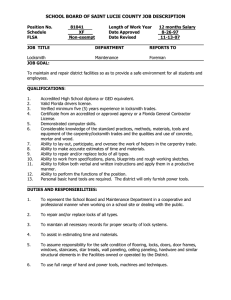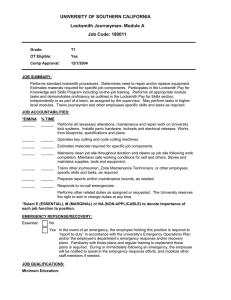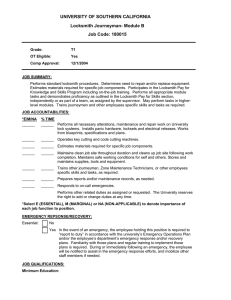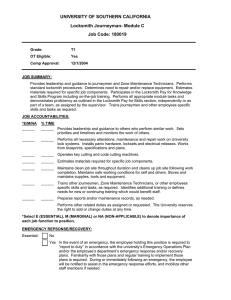Why Should I be certified? - Associated Locksmiths of America
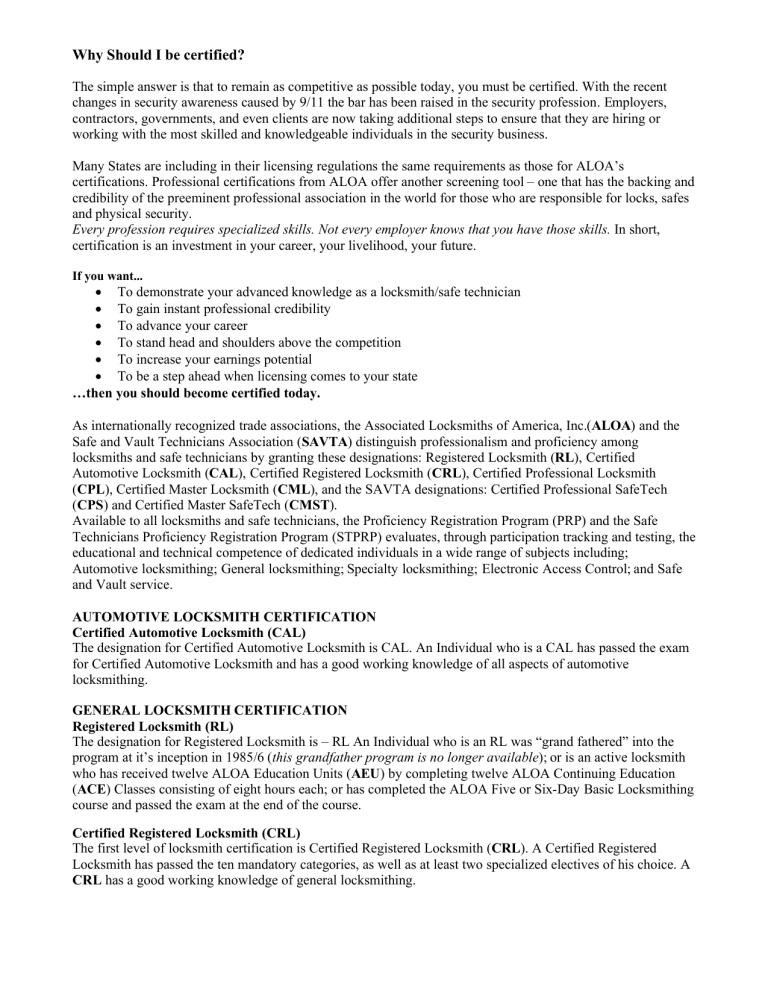
Why Should I be certified?
The simple answer is that to remain as competitive as possible today, you must be certified. With the recent changes in security awareness caused by 9/11 the bar has been raised in the security profession. Employers, contractors, governments, and even clients are now taking additional steps to ensure that they are hiring or working with the most skilled and knowledgeable individuals in the security business.
Many States are including in their licensing regulations the same requirements as those for ALOA’s certifications. Professional certifications from ALOA offer another screening tool – one that has the backing and credibility of the preeminent professional association in the world for those who are responsible for locks, safes and physical security.
Every profession requires specialized skills. Not every employer knows that you have those skills.
In short, certification is an investment in your career, your livelihood, your future.
If you want...
•
To demonstrate your advanced knowledge as a locksmith/safe technician
•
To gain instant professional credibility
•
To advance your career
•
To stand head and shoulders above the competition
•
To increase your earnings potential
•
To be a step ahead when licensing comes to your state
…then you should become certified today.
As internationally recognized trade associations, the Associated Locksmiths of America, Inc.( ALOA ) and the
Safe and Vault Technicians Association ( SAVTA ) distinguish professionalism and proficiency among locksmiths and safe technicians by granting these designations: Registered Locksmith ( RL ), Certified
Automotive Locksmith ( CAL ), Certified Registered Locksmith ( CRL ), Certified Professional Locksmith
( CPL ), Certified Master Locksmith ( CML ), and the SAVTA designations: Certified Professional SafeTech
( CPS ) and Certified Master SafeTech ( CMST ).
Available to all locksmiths and safe technicians, the Proficiency Registration Program (PRP) and the Safe
Technicians Proficiency Registration Program (STPRP) evaluates, through participation tracking and testing, the educational and technical competence of dedicated individuals in a wide range of subjects including;
Automotive locksmithing; General locksmithing; Specialty locksmithing; Electronic Access Control; and Safe and Vault service.
AUTOMOTIVE LOCKSMITH CERTIFICATION
Certified Automotive Locksmith (CAL)
The designation for Certified Automotive Locksmith is CAL. An Individual who is a CAL has passed the exam for Certified Automotive Locksmith and has a good working knowledge of all aspects of automotive locksmithing.
GENERAL LOCKSMITH CERTIFICATION
Registered Locksmith (RL)
The designation for Registered Locksmith is – RL An Individual who is an RL was “grand fathered” into the program at it’s inception in 1985/6 ( this grandfather program is no longer available ); or is an active locksmith who has received twelve ALOA Education Units ( AEU ) by completing twelve ALOA Continuing Education
( ACE ) Classes consisting of eight hours each; or has completed the ALOA Five or Six-Day Basic Locksmithing course and passed the exam at the end of the course.
Certified Registered Locksmith (CRL)
The first level of locksmith certification is Certified Registered Locksmith ( CRL ). A Certified Registered
Locksmith has passed the ten mandatory categories, as well as at least two specialized electives of his choice. A
CRL has a good working knowledge of general locksmithing.
Certified Professional Locksmith (CPL)
The second level of locksmith certification is Certified Professional Locksmith ( CPL ). A Certified Professional
Locksmith has earned the CRL designation and has successfully in an additional twelve elective categories. A
CPL has an advanced knowledge of general locksmithing and of many specialized areas.
Certified Master Locksmith (CML)
The highest level of locksmith certification is Certified Master Locksmith ( CML ). A Certified Master
Locksmith has reached the highest level of ALOA’s Proficiency Registration Program and has successfully demonstrated proficiency in ninety percent of the available categories of the Proficiency Registration Program.
A CML has advanced knowledge of most areas of locksmithing and electronic security.
All of the examinations for certification in the Proficiency Registration Program are written examinations which currently consist of thirty-six categories, ten of which are mandatory.
The mandatory exam categories are
•
Codes and Code Equipment
•
Cylinder Servicing
•
Key Blank Identification
•
Key Duplication
•
Key Impressioning
•
Professional Lock Opening Techniques
•
Lockset Functions
•
Lockset Servicing
•
Basic Master Keying
•
Cabinet, Furniture and Mailbox Locks
The mandatory categories are combined into one test booklet containing 250 questions and must be passed with a cumulative score of 70%.
The remaining twenty-six categories are elective exams that may be selected according to each locksmith’s field of specialization or expanding knowledge. This number will vary as technology changes. Each elective contains between twenty-five and forty questions, depending on the subject covered.
The elective exam categories are:
•
L-03 Domestic Automotive
•
L-04 Foreign Automotive
•
L-05 Door Closers
•
L-07 Life Safety Codes
•
L-08 High Security Cylinder Servicing
•
L-11 Special Application Cylinder Servicing
•
L-12 Tubular Key Cylinder Servicing
•
L-13 Basic Electricity
•
L-16 Exit Hardware and Exit Alarms
•
L-20 Keyless Mechanical Locks
•
L-21 Lever Tumbler/Non-Safe Deposit Locks
•
L-22 Motorcycle Locks
•
L-24 Safe Combination Locks
•
•
•
•
•
•
•
•
•
•
•
•
L-25 Safe Deposit Locks
L-26 Time Locks
L-28 Lockset Installation
L-31 Advanced Master Keying
L-32 Safe Installation
L-33 Safe Opening and Servicing
L-38 Small Format Interchangeable Core
L-39 Large Format Interchangeable Core
L-40 Electromechanical Access Control
L-41 Related Door Hardware
L-42 Alarms
L-43 Detention Locking Systems
The elective categories are in separate booklets and the passing score for each elective is 70%.
To achieve the Certified Automotive Locksmith certification (CAL), a passing grade of (70%) is required on the
300 question automotive locksmithing exam.
To achieve the first level of general locksmith certification, Certified Registered Locksmith , a passing grade
(70 %+) is required on the mandatory section and any two selected electives.
To achieve the intermediate level of certification, Certified Professional Locksmith , a passing grade (70 %+) is required on each of any twelve additional selected electives.
To achieve the highest level of certification, Certified Master Locksmith , a passing grade (70 %+) is required on 90% of the total number of categories available which currently is each of any nine of the remaining electives.
SAFE TECHNICIAN CERTIFICATION LEVELS
The SAVTA Safe Technicians Proficiency Registration Program ( STPRP ) consists of two levels.
The first level of the STPRP certification is Certified Professional Safe Technician ( CPS ) – A CPS has successfully demonstrated proficiency in 17 safe and vault related categories such as:
•
Lock Identification
•
UL Standards For Safes
•
Vault and Safe Locks
•
SMNA & JIS Ratings
•
Tools and Their Usage
•
Safe Lock Servicing and Changing
•
Troubleshooting and Dialing Diagnostics
•
The Theory of Manipulation
•
Safe Lock Installation
•
Basic Safe and Lock Construction
•
Safe Installation
•
GSA Equipment
•
Safe and Vault Door
•
•
•
•
•
Adjustments/Alignment
Safe Drilling/Penetration
Post-Penetration Repairs
Safe Deposit Locks
Key-Operated Safe Locks
Safe-Related Electronics
Certified Master Safe Technician (CMST)
The highest level of the Safe Technicians certification Certified Master Safe Technician ( CMST ) – A CMST has successfully demonstrated advanced proficiency in safe and vault related categories such as:
•
Lock Identification
•
UL Standards For Safes
•
Vault & Safe Locks
•
SMNA & JIS Ratings
•
Tools & Their Usage
•
Safe Lock Servicing & Changing
•
Troubleshooting & Dialing Diagnostics
•
The Theory Of Manipulation
•
Safe Lock Installation
•
Basic Safe & Lock Construction
•
Safe Installation
•
GSA Equipment
•
Safe & Vault Door Adjustments & Alignment
•
Safe Drilling
•
Post-Penetration Repairs
•
Safe Deposit Locks
•
Key-Operated Safe Locks
•
Safe-Related Electronics
•
Advanced Dialing Diagnostics
•
Manipulation
•
Uncommon Safes & Locks
•
Advanced Safe Deposit Locks
•
Time Locks
•
Night Depositories
•
High-Security Safe Construction
•
Safe Penetration
•
Advanced Borescope Techniques
•
Composite & High-Security Safe Repair
•
Vaults & Vault Doors
To achieve the first level of certification, Certified Professional Safetech , a passing grade (70 %+) is required on the 325 question Certified Professional Safetech written exam.
To achieve the highest level of certification, Certified Master Safe Technician , you must have completed the requirements for the CPS level and achieve a passing grade (70 %+) on the 267 question Certified Master Safe
Technician written exam.
REGISTRATION PROCEDURES
Look on the ALOA web site www.aloa.org/education Certification Exam Schedule for the PRP Schedule or in the ALOA membership magazine Keynotes calendar for a scheduled exam in your area. Download the registration form from the website or contact the local sponsor for a registration form.
DEADLINE
The registration deadline is fifteen days prior to the evaluation.
FOR THE FIRST SITTING
Automotive Locksmith: Select the A-00 Mandatory exam.
Locksmith:
Safe Technician:
The Mandatory (L-00) and any two electives may be selected.
The Certified Professional SafeTech (CPS) exam is selected.
FOR ADDITIONAL SITTINGS
Automotive Locksmith:
After receiving the letter with the evaluation scores If you did not pass the CAL exam, you may retake the exam at any future sitting
Locksmith:
After receiving the letter with the evaluation scores, you may register for the next convenient sitting.
If the level of CRL was reached successfully on the first try, select any twelve of the remaining electives.
If the level of CRL was not achieved at a single sitting, two options are available:
1.
If zero, one or two electives were passed and the mandatory was not passed, then only the Mandatory and the necessary electives required to achieve the level of
CRL may be retaken.
2.
If the Mandatory was passed and one or more electives failed, any nine electives may be selected. Passing two electives will complete the requirements for the level of CRL. Any remaining electives passed will be credited to the next level.
If an elective is not successfully completed, it may be retaken at any future sitting.
Up to nine electives may be selected for each additional sitting.
Safe Technician:
After receiving the letter with the evaluation scores, you may register for the next convenient sitting.
If the level of CPS was reached successfully on the first try, you may register for the
CMST exam which is given only at limited locations and the ALOA and SAVTA conventions .
If you did not pass the CPS exam, you may retake the exam at any future sitting.
FEES
Administrative fees set by the ALOA/SAVTA PRP/STPRP Committee are uniform regardless of the location of the evaluation. However, fees for individual sittings are set by the sponsoring group and may vary depending on the sponsor hosting the sitting and their expenses.
PRP/STPRP LEVEL SUMMARY
COMPLETE THIS:
CAL Mandatory Exam
Mandatory Categories + 2 Electives
CRL + 12 Electives
CPL + 9 Remaining Electives
CPS Mandatory exam
TO ACHIEVE THIS LEVEL
CAL
CRL
CPL
CML
CPS
CPS Mandatory exam + CMST exam CMST
TRAINING
ALOA conducts training to achieve certification in many different formats that include over 100 classes at the annual ALOA Convention which will be in Orlando, Florida, August 1 – 8, 2010 .; at the ALOA Training
Center in Dallas, Texas where hands on instructor led classes are conducted throughout the year; at contracted regional conventions and at many locally sponsored weekend seminars throughout the year. A calendar of
ALOA certified class presentations is on our website www.ALOA.org . ALOA presents a Six Day Basic
Locksmithing Course that is a useful review for those already working in a lockshop environment to receive the formal training on the categories that are covered in the CRL Mandatory exam. ALOA also provides a bookstore (http://www.aloa.org/store/ ) where members can purchase books CD’s and videotapes on a wide variety of locksmith subjects. ALOA members can check out videotapes from the ALOA Video Library.
We are currently in the process of developing several additional Online Education opportunities as well.
ALOA also maintains a list of schools (http://www.aloa.org/pdf/locksmithingschools.pdf ) that offer correspondence, resident and traveling resident training.
In addition SAVTA conducts comprehensive safe technician training at the SAFETECH Convention which will be in San Diego, California, April 19 – 24, 2010 .
ALOA has certified over 4,000 locksmiths worldwide with an additional 2,900 who are presently in the early stages of certification. ALOA provides the licensing exam for the State of Illinois Department of Professional
Regulation, the North Carolina Locksmith Licensing Board and has worked with other city and state agencies in setting up their qualifications for locksmith hiring and requirements for licensing.
ALOA offers a PRP Resource Guide (member price $20.00) that provides more in depth information about each of the locksmith categories as well as references for study. ALOA also offers the Safe Technicians
Reference Manual ($135.00) for those who are preparing for the CPS or CMST certification levels.
You may order this in the online ALOA Store. http://www.aloa.org/store/ or be calling the ALOA Headquarters
Order Department at 800-532-2562 x105.
